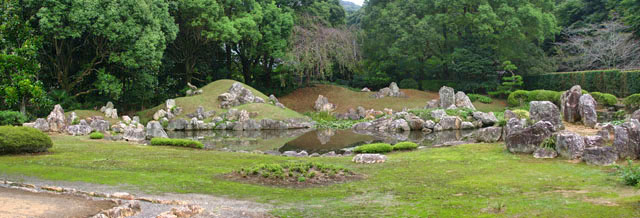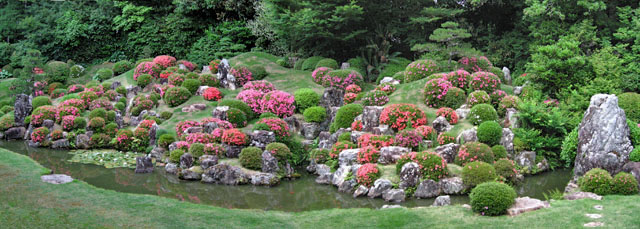
Japanese garden of Makaya-ji (in the Kamakura era, the13th C.) on Oct. 02.2007.
The style of Japanese garden has a character of its own and is different from that of Western gardens as Italian and French. As the elements determining their styles these things are mentioned, such as plants, weather, stones, the lay of the land and other natural elements, moreover, social, cultural and scientific technical factors.
Landscape style Japanese garden is classified roughly into 3 components, that is, Tsukiyama, Hiraniwa and Roji, and the Sekiyo-boku is one component composing Tsukiyama, which has a role to block off the light of the afternoon sun, so is planted at the west part of the garden, and for which the broad-leaved trees changing their colors in autumn seem to fit. Here maples, cherry trees and plum trees are recommended.
"Japan the Beautiful and Myself" by KAWABATA Yasunari also shows the following description.
" The Japanese garden too, of course, symbolizes the vastness of nature. The Western garden tends to be symmetrical, the Japanese garden asymmetrical, for the asymmetrical has the greater power to symbolize multiplicity and vastness. The asymmetry, of course, rests upon a balance imposed by delicate sensibilities. "Nothing" is more complicated, varied, attentive to detail than the Japaneseart of landscape gardening. Thus there is the form called the dry landscape, composed entirely of rocks, in which the arrangement of the rocks gives expression to mountains and rivers that are not present, and even suggests the waves of the great ocean breaking in upon cliffs. Compressed to the ultimate, the Japanese garden becomes the bonsai dwarf garden, or the bonseki, its dry version."
Let me show you Japanese gardens which are located in the the suburbs of the city of Hamamatsu.


Japanese garden of Ryotanji temple (in the Edo era, the 17th C.) by KOBORI Enshu, on May 28, 2007
Let me show you maples and well-known Japanese gardens where I have visited.
Maples such as "iroha-momiji", "yama-momiji", "oh-momiji" and their cultivars, "toh-kaede" and its cultivars, moreover, "hauchiwa-kaede", "itaya-kaede" and their cultivars are used by many people as the favorite gardening trees with the garden culture for a ground back.
Well-known Japanese gardens where I have visited
I would like to arrange them in chronological order within my confined cognizance.
1. From old days to the 13th century
1. East Palace Garden, Nara Palace Site, Nara Pref. excavated in 1976 2. Remains of Heijokyo Sakyo Sanjo Nibo Palace Garden, in Nara excavated in 1977 3. Ohsawa Pond (Old Teiko Garden) Imperial Palace of Saga, Daikakuji Temple, Kyoto 814
4. Byodoin Phoenix Hall, modeled after the palace in the Land of Happiness 5. Maples & "Mohtsuji Temple" in Iwate Pref. 1145 6. Johruriji Temple in Kidugawa City, Kyoto Pref. 1150, 1205, 1304, 1410 7. Shakusuien Garden, well-known for the "Yodomari-ishi", in the end of the Heian era 8. Shomyoji Temple in Kanagawa Pref. 1262
|
2. From the14th to the16th century
9. Eihoji Temple in Gifu Pref. 1312 10. Erinji Temple Garden, juxtaposed two worlds, Yamanashi Pref. 1330 11. Nanzen-in Garden typifying the Kamakura era 1334 12. Dry landscape Garden of Saihoji Temple in Kyoto 1339, 1379, 1486,1568 13. Tenryuji Temple in Kyoto 1341 14. Funda-in Temple as Sesshu-ji Temple has a dry landscape garden by Sesshu. 15. Maples & Kinkakuji Temple in kyoto 1397, 1536
16. Sesshu Garden of Mampuku-ji Temple in Masuda city Shimane Pref. 1479 17. Maples & Ginkakuji Temple in Kyoto 1482 18. The Rock Gardens of Ryohgen-In Temple, Kyoto 1510 19. Kare Sansui, The Rock Garden of Daisen-In Temple, Kyoto 1513
20. The Rock Garden of Taizoin Temple in Kyoto 1536 21. The Rock Garden only with 15 rocks & white gravel, Ryoanji Temple, in Kyoto 1450, 1488 22. The Garden of Shoren-in with elegance at Awatayama hill in Kyoto 23. A Maple on the stone & Old Shurinji Temple Garden in Shiga Pref. 1529 24. Kitabatake-Yakata-ato Garden in Mie Pref. 1529 25. A maple & Echizen-Ichijohdani Suwayakata-ato Garden in Fukui Pref.1566, 1569
|
26. Nijo Castle Ninomaru Palace Garden in Kyoto 1601, 1630, 1645 27. Kohtoh-in Garden, a masterpiece of elegant simplicity, called "Garden of Maple", in Kyoto 28. Kohdai-ji Temple Garden known for the Engetsuchi pond garden by KOBORI Enshu 29. Nanzen-ji Temple Hohjoh Garden with wide blank of gravel in Kyoto 1611 30. Garden of "Shuon-an Ikkyu-ji Temple" in Kyo-tanabe city Kyoto Pref. 1467,1475,1654 31. Chishaku-in Temple Garden with "Kaede-zu" by HASEGAWA Toh-haku in Kyoto 32. Shukkeien modeled on West Lake in China, in Hiroshima 1620 33. Katsura Imperial Villa in Kyoto 1620 34. Entokuin Garden with the gorgeousness of the stones formation in Kyoto 1624 35. Koishikawa Kohrakuen garden in Tokyo 1629 36. Konchi-in Garden of Nanzen-ji Temple well-known as the Crane and Turtle Garden 1632 37. Shisendo Mountain Villa in Kyoto 1633 38. Sento Imperial Palace in Kyoto 1421,1606,1636 39. The Shohsei-en Garden (Kikoku-tei) in Kyoto 1650 40. Shugakuin Imperial Villa in Kyoto 1655 41. Shiga-in Monzeki Garden in Ohtsu, Shiga Pref. 1655 42. Garden of Manshu-In Monzeki Temple in Kyoto 1656 43. Garden of Rengeji Temple in Kyoto 1666 44. "Hohrai" Garden of Daichiji Temple in Kouga City, Shiga Pref. 1667 45. Maples & Enkoji Temple in Kyoto 1667 46. "Toh-kaede" & Hamarikyu Onshi Teien(Garden) in Tokyo 1669 47. Ritsurin Park in Kagawa Pref. 1673 48. A maple & Kotoji lantern, Kenroku-en Garden in Ishikawa Pref. 1676 49. Genkyu Rakurakuen Garden was built in the early Edo era, 50. Okayama Kohraku-en Garden in Okayama Pref. 1687 51. Rikugi-en Garden in Tokyo 1695
|
4. From the 18th century downward
52. Old Shibarikyu Onshi Teien in Tokyo 1678, 1846 53. Saimyoji Temple Garden in Shiga Pref.1757 54. Kongohrinji Temple Garden in Shiga Pref. 1633,1820, 1852 55. Hyakusaiji Temple in Shiga Pref.
56. Kiyosumi Garden in Tokyo 1891 57. Murin-an Garden with a new sense in the Meiji era in Kyoto 1896 58. Isuien Garden in Nara 1673, 1899 59. Sankeien Garden in Kanagawa Pref. 1906 60. Enri-an Garden giving us a sense of intimacy as our garden, in Kyoto 1910 61. Maruyama park with the murmur of the stream, where a flavor of "Yarimizu" 62. Old-Furukawa Garden in Tokyo 1917 63. Old Yasuda Garden in Tokyo 1691, 1927 64. Mirei's Gardens, Tofuku-ji Temple in Kyoto 1938 65. The Sacred Garden "Rakusuien" of Johnangu Shrine in Kyoto 1960 66. Mirei's Gardens, Zuiho-In Temple in Kyoto 1961 67. The Garden of Adachi Museum of Art in Yasugi city Shimane Pref. 1972 68. Gardens of Matsuo Grand Shrine in Kyoto 1975
68. Suzaku Garden in Umekohji Park in Kyoto 2009 68. Suikei-en Garden in Keihanna Commemorative Park in Kyoto 2009 |